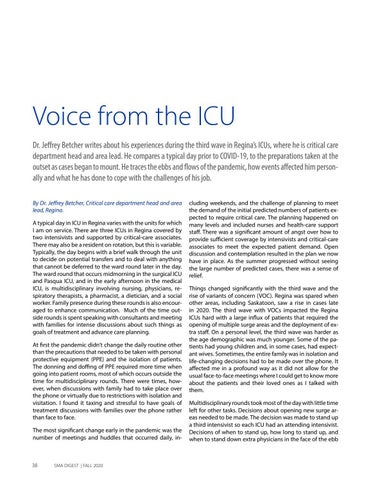Voice from the ICU Dr. Jeffrey Betcher writes about his experiences during the third wave in Regina’s ICUs, where he is critical care department head and area lead. He compares a typical day prior to COVID-19, to the preparations taken at the outset as cases began to mount. He traces the ebbs and flows of the pandemic, how events affected him personally and what he has done to cope with the challenges of his job. By Dr. Jeffrey Betcher, Critical care department head and area lead, Regina. A typical day in ICU in Regina varies with the units for which I am on service. There are three ICUs in Regina covered by two intensivists and supported by critical-care associates. There may also be a resident on rotation, but this is variable. Typically, the day begins with a brief walk through the unit to decide on potential transfers and to deal with anything that cannot be deferred to the ward round later in the day. The ward round that occurs midmorning in the surgical ICU and Pasqua ICU, and in the early afternoon in the medical ICU, is multidisciplinary involving nursing, physicians, respiratory therapists, a pharmacist, a dietician, and a social worker. Family presence during these rounds is also encouraged to enhance communication. Much of the time outside rounds is spent speaking with consultants and meeting with families for intense discussions about such things as goals of treatment and advance care planning. At first the pandemic didn’t change the daily routine other than the precautions that needed to be taken with personal protective equipment (PPE) and the isolation of patients. The donning and doffing of PPE required more time when going into patient rooms, most of which occurs outside the time for multidisciplinary rounds. There were times, however, when discussions with family had to take place over the phone or virtually due to restrictions with isolation and visitation. I found it taxing and stressful to have goals of treatment discussions with families over the phone rather than face to face. The most significant change early in the pandemic was the number of meetings and huddles that occurred daily, in-
38
SMA DIGEST | FALL 2020
cluding weekends, and the challenge of planning to meet the demand of the initial predicted numbers of patients expected to require critical care. The planning happened on many levels and included nurses and health-care support staff. There was a significant amount of angst over how to provide sufficient coverage by intensivists and critical-care associates to meet the expected patient demand. Open discussion and contemplation resulted in the plan we now have in place. As the summer progressed without seeing the large number of predicted cases, there was a sense of relief. Things changed significantly with the third wave and the rise of variants of concern (VOC). Regina was spared when other areas, including Saskatoon, saw a rise in cases late in 2020. The third wave with VOCs impacted the Regina ICUs hard with a large influx of patients that required the opening of multiple surge areas and the deployment of extra staff. On a personal level, the third wave was harder as the age demographic was much younger. Some of the patients had young children and, in some cases, had expectant wives. Sometimes, the entire family was in isolation and life-changing decisions had to be made over the phone. It affected me in a profound way as it did not allow for the usual face-to-face meetings where I could get to know more about the patients and their loved ones as I talked with them. Multidisciplinary rounds took most of the day with little time left for other tasks. Decisions about opening new surge areas needed to be made. The decision was made to stand up a third intensivist so each ICU had an attending intensivist. Decisions of when to stand up, how long to stand up, and when to stand down extra physicians in the face of the ebb

















